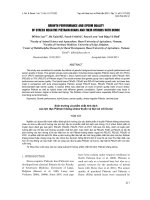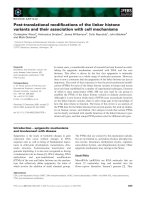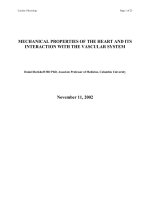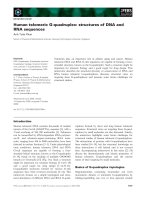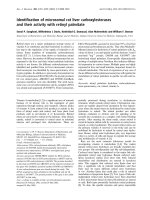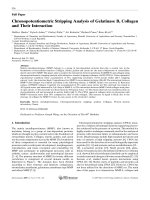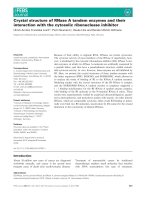Synthesis and structure investigation of stabilized aromatic oligoamides and their interaction with g quadruplex structures 1
Bạn đang xem bản rút gọn của tài liệu. Xem và tải ngay bản đầy đủ của tài liệu tại đây (411.75 KB, 18 trang )
1
Chapter 1
Introduction
1.1 Background
In nature, most of the amazing functions carried out by biomacromolecules, such as
molecular recognition, catalysis and information storages, involve compact and stable
solution structures approaching conformational uniqueness. In order to gain deeper
insight into the operation of the nature’s biomacromolecules as well as to identify new
molecules that display bio-functional performances, developing new molecules that
adopt well-defined conformations have been the object of very active research during
the last twenty years. This field of study has come to be known as foldamers.
Foldamers were defined as oligomers that fold into a conformationally ordered state
in solution, the structures of which are stabilized by a collection of noncovalent
interactions among monomer units.
1
To design foldamers rationally, several issues within the field of protein folding
should be taken into consideration. Predictability is the primary consideration in the
design of secondary motifs to determine the potential usefulness of foldamers. In
addition, stability, tunability and ease of synthesis are also essential features for
designing foldamers. Until now, two major categories of foldamers have been studied:
single-stranded foldamers that fold (peptidomimetics and their abiotic analogues) as
well as multiple-stranded foldamers that both fold and associate (nucleotidomimeitics
2
and their abiotic analogues). Generally, single-stranded abiotics are unnatural
backbones that mimic secondary structures, such as folding and helices, while
multi-stranded foldamers simulate such as double-helical conformations existing in
oligonucleotides.
Since the pioneering work of Gellman,
2
single-stranded oligomers that fold into
well-defined secondary structures have been extensively investigated. In the earlier
studies, a large number of artificial peptidomimetic systems such as aliphatic
α
-,
β
-,
γ
-, and
δ
-peptides
3
were designed and synthesized. With the development of
structurally unique folding patterns, the applications of such synthesized secondary
structures in discrete areas have been broadened. For example, several folded
α
-peptides have been revealed to display strong antibacterial and antimicrobial
activity.
4,5
Recently, there has been increasing interest in identification of novel and unnatural
backbones which fold into secondary structures akin to those found in proteins. The
advantages of these foldamers include rigidity inherent in aromatic units, torsional
flexibility of the linkers and various nonconvalent interactions that enforce discrete
folded conformation. Considering these advantages, single-stranded foldamers with
various abiotic backbones have been studied, including backbones utilizing bipyridine
segments,
6
solvophobic interaction,
7
hydrogen-binding interactions
8
and metal
coordination.
9
However, the challenges in designing synthetic folding oligomers exist
in terms of folding stability, tunability, and the control of conformational changes
under distinct conditions in which molecules adopt various secondary structures.
3
Among the artificial foldamers reported, aromatic oligoamides utilizing hydrogen
bonding to control the folding conformations have been proven to substantially
alleviate these challenges. These foldamers aryl amide has been used very often to
connect building blocks together. In general, most oligoamides make use of in
H-bonding interactions between adjacent monomer units. Although interactions
between remote units in the sequence may also contribute to the stability of the
structure, it was not the predominant factor that determines how the molecule may
fold. In this way, these foldamers often contain a few sets of distinct monomer
building blocks that make up regularly ordered backbone.
1.2 Literature Review
1.2.1 Linear Aromatic Oligoamides
The simplest structural motif of aromatic oligoamides is the linear strand. In a
linear oligomer, there is almost no contact between aromatic units remote from each
other. Several building blocks allowing the construction of linear conformation are
shown in Figure 1.1. Oligoamides of anthranilic acid was first reported by Hamilton
et al. as linear oligoamides.
10
Another example is oligomers of
2,5-bis(2-aminophenylene) pyrazine (Figure 1.1b).
11
Usually, those oligomers exhibit good linearity due to the formation of the
hydrogen bonds on both sides of the molecular strand. In contrast, some linear strands
are not expected to be strictly linear and a curvature in backbone could be observed
due to the presence of hydrogen bond located at only one side of the strand. For
4
example, oligoamides of 6-alkoxy-5-aminopicolinic acid form linear motif in which
the amide protons hydrogen-bond to both the ether oxygen atom and the endocyclic
pyridine nitrogen atom at the same side (Figure 1.1c).
12
Due to the slight curvature,
the facial polarity of those strands was reported to be useful for molecular recognition.
For example, Ishu Saraogi et al. reported a family of oligoamide with controlled
curvature serving as α-helix mimetics.
15
Another α-helix proteomimetics is
N-alkylated aromatic oligoamides reported by Frederick Campbell.
17
Further
modification of those partially linear structures leads to bend structures. For example,
Gong et al. prepared an oligoamides adopting bend structure by replacing the
endocyclic nitrogen atom of 6-alkoxy-5-aminopicolinic acid with an exocyclic
methoxy hydrogen-bond acceptors (Figure 1.1d).
13
a) b) c)
d)
Figure 1.1. Aromatic Oligoamides adopting linear conformations (a,b,c).
However, aromatic oligoamide foldmer may undergo conformational changes via a
syn-to-anti or anti-to-syn 180º rotation. For example, A transition between linear to
turn conformational switch of unsymmetrically linked phenolic oligoamides has been
5
reported through deprotonation.
22
The deprotonation of a hydroxyl group in each unit
induces a rearrangement of the hydrogen-bonding mode within the unit from
OH…O=C to NH…O (oxyanion), which leads to linear-to-turn conformational
switching.
Figure 1.2. Proposed conformational change of aromatic oligoamides in solution.
1.2.2 Crescent and Helical Aromatic Oligoamides
Among all aromatic oligomers, crescent-shaped oligomers or helices have received
particular interests. Usually, these oligomers consist of a single repeating unit.
Some examples are shown in Figure 1.1. Curvature of aromatic oligoamide is resulted
when amine and acid substituents define an angle smaller than 180
o
. For short
oligomers having a rigid, curved backbone, the structures are planar and crescent-
shaped since there is no sufficient repulsive interactions between end units. As its
chain length extends, oligomers are deviated from planarity so as to form helices.
Based on this principle, the group of Hamilton,
29
Lehn,
28
Gong,
13
Huc
15
and Li
16
made a great contribution in developing crescent and helical structures containing
cavtities with tunable sizes since 1999.
6
Gong’s group firstly designed a hydrogen-binding rigidified crescent aromatic
oligoamides containing benzene residues meta-linked by amide linkages, as shown in
Figure 1.1d.
13a
The reliability of the three-center H-bonds in rigidifying the
oligoamide backbone was demonstrated by the well-defined crescent conformation of
dimer, trimer and tetramer. According on this three-center H-bonding, a 9-mer and a
11-mer were synthesized and structures were investigated.
13b-d
The longer oligoamides
adopt, both in the solid state and in the chloroform solution, a helical structure with
approximately seven benzene rings per turn and an inner diameter of 10
Å.
Huc’group has researched extensively into the helical structures enforced by
aromatic pyridine oligoamides. They first reported an elegant system of double helical
aromatic oligoamides consisting of pyridine residues, with backbones rigidified by
intramolecular H-bonds in 2000.
14a,14o
The X-ray crystal structure demonstrated the
presence of ellipsoid helices with an inner diameter of 5.5 Å (n=2) and 8 Å (n=4). In
addition, these oligoamide helices can also further dimerize at higher concentrations,
forming a stable double helix in solution. Within the double helix, the two oligomer
strands are held together by arene-arene interactions between pyridine rings lying
opposite each other (Figure 1.3b). In addition, sequences comprised of quinoline,
14f-h
8-fluoroquinoline
14e
and pyridoquinoline monomers,
14g
as well as combinations
thereof,
14i-l
were reported to adopt double helices with a large diameter. Among these
studied, the most prominent finding is the observation of a tetramer composed of
fluoroqinolinecarboxamide-based oligomers that adopt a helical conformation with a
large pitch, which allows the formation of a quadruple helix both in solution and the
7
solid state (Figure 1.3c and 1.3d). Also, they found that naphthyridine oligoamides
can spontaneously assemble in parallel and antiparallel triple helices.
14m
Figure 1.3.
14e
Crystal structures of Huc’s aromatic oligoamides: (a) a single helix made of
7-amino-8-fluoro-2-quinolinecarboxylic acid building blocks with the fluorine atoms shown as blue
spheres that converge towards the helix hollow space, (b) a narrow double helix composed of pyridine
rings only,
14b
(c) a quadruple helix composed of four identical single helices shown in (a), a string of
sites partially occupied by water molecules is shown as spheres, (d) octameric amides of
7-amino-8-fluoro-2-quinolinecarboxylic acid, as a double helix.
Other than above foldamers, aromatic oligoamides based on other monomeric units
or linkages have also been reported recently. For example, alternating aromatic
heterocycles and methyl-substituted aromatic carbocycles connected together through
urea linkage have been synthesized.
16
In addition, Li et al. reported a folding
architecture utilizing F···H-N hydrogen bonds.
25d
8
Figure 1.4. Helix formation by intramolecular hydrogen bond.
13c
The deviation of helices from planarity is achieved by slight changes of the
torsional angles involving every aryl-amide bond. When one helical turn comprises
many repeating units,
13
the torsion is minimal. The torsions are larger for highly
curved helices with only a few units per turn (Figure 1.4). By tuning parameters of
helical cavity, the applications of these helical oligoamides have been extended.
Usually, helices with a large hole or those with few units per turn permit easy access
to objects with a high aspect ratio at minimal synthetic efforts.
18
On the other hand,
helices with a large diameter can be exploited as a cylindrical channel that may be
applied for molecule recognition, catalysis and transport.
19
a) b)
Figure 1.5. A typical structure of aromatic oligoamide -Cl
-
complex.
20a
9
Those helical aromatic foldamers have been demonstrated to display a number of
interesting supramolecular properties, especially host-guest chemistry.
20a
One
noticeable example is the helices formed by oligoamides of 2,6 pyridinediarboxylic
acid and 2,6-diaminopyridine that contain a polar hollow which may bind water
molecules (Figure 1.3c).
14b
What’s more, helically folded oligomers possessing a
hollow cavity is able to provide confined environments suitable for recognizing chiral
guests due to their inherent chirality. Based on this concept, the encapsulation of
tartaric acid in a helically folded aromatic oligoamide was presented.
20b
Very high
affinities, guest selectivities and diasteroselectivies have been observed that bode well
for extensions of this approach to larger and more complex guests. Finally, crescent
oligoamides have also been found to act as hosts for substituted guanidinium ions
21
or
dialkylammonium
25d
with high specificity and affinity.
Figure 1.6. Solid state structure of L-tartaric Acid-binding M-1 helix. (a) CPK and (b) stick
representations of the M-1 helix. (c) Top view of the central part of the M-1 helix, showing tartaric acid
H-bonded to N2-pyr-pyz-pyr-N2.
Therefore, oligoamides with helical conformation are fascinating considering their
nonplanar structures. Such molecules should be inherently chiral, resulting in amazing
optical and electronic properties. In addition, supramolecular helices could be formed
10
by the columnar stacks caused by π-π interaction. However, until now, the consistent
columnar packing of these shape-persistent crescent and helical oligoamides has
rarely been studied.
1.2.3 Circular Aromatic Oligoamides
As mentioned in 1.2.2, one of the most important applications of hollow cavities
contained within the aromatic oligoamides is their potential to bind corresponding
guest molecules. Based on this intention, circular oligoamides, as a kind of
macrocycles, were designed. Shape-persistent circular oligoamides are structures with
rigid, noncollapsible backbones and lumens of various sizes. These structures are very
interesting because of their unique properties that differ from their linear analogues.
However, examples of these molecules are rare, mainly attributed to the difficulty in
their preparation and lack of the suitable building blocks. Some of reported examples
are elaborated below.
Gong’s group pioneered the work of H-bonding enforced macrocycles by
synthesizing a new class of shape-persistent, cyclic hexa(armides) from the one-step
macrocyclization involving monomeric diamine and diacid chloride.
23
Macrocycles 1
contain a large (8Å across), noncollapsible hydrophilic cavity defined by six
introverted amide oxygen atoms. The face-to-face stacking of 1 may align the
macrocycles into nanotubes containing a large channel (or nanopore) (Figure 1.7). As
expected, this class of macrocycle was demonstrated to form transmembrane channel
with very large conductance and a model of the transport pore was prompted as
11
Figure 1.7b.
24
Figure 1.7. Circular aromatic oligoamides from Gong’s group. (a) Chemical structures of shape
persistent macrocyles 1, (b) with their large aromatic surfaces, 1 assemble anisotropically into a tubular
structure that acts as a transmembrane channel or pore in the hydrophobic environment of a lipid
bilayer.
Li’s group also demonsrated that hydrogen bonding-induced aryl amide foldamer
could function as new synthetic receptors for binding neutral and ionic species or as
preorganized scaffolds for assembling well-defined architectures.
25
Furthermore, they
prepared a new rigidified macrocycle that complex fullerene or coronene in
chloroform viah intromolecular π-stacking interactions, as in Figure 1.8.
25i
Figure 1.8. Stacking interaction between C
60
and macrocycle from Li’s group.
In addition to the application in molecular recognition and ion transportation,
macrocycle based on aromatic oligoamides was also found to bind to DNA
G-quadruplex through intermolecular hydrogen bonding and/or л-л stacking
12
interaction. G-quadruplexs, unlike double-stranded oligonucleotides, are made up of
symmetric planar guanine-mediated quartets (G-quartets) in which each guanine
forms two hydrogen bonds with its neighbors (Figure 1.9).
Since these G-quartets have large π-surfaces, they tend to stack on each other by
π-π stacking. In particular, oligonucleotides with contiguous runs of guanine bases
can form stacked G-quadruplex structures.
26
Accordingly, G-quadruplex ligands
generally comprise a planar π-rich pharmacophore, presumed to bind to guanine
tetrads, with appended side chains to enhance the binding interaction. Some additional
lines of evidences suggest that stable G-quadruplex structures are poor substrates for
interaction with telomerase, thereby disfavoring the telomere extension by
telomerase.
30-32
The above findings provide compelling evidence
33-39
that small
molecules that target and stabilize telomeric G-quadruplexes may display anticancer
activity by interfering with either the 1:1 complex formed between telomerase and
telomere or other molecular pathways underlying the telomere elongation by
telomerase, a process that enables cancer cells to proliferate indefinitely; consequently,
immortal cancer cells may become mortal while the corresponding side effects on
human cells could be very minimal as, contrasting with cancel cells, most human
somatic tissues have very limiting telomerase activity.
40,41
Since circular oligoamides rich in π-electrons usually adopt very stable, planar
conformations, they should be able to stabilize G-quadruplex structures. For example,
8-amino-2-quinoline carboxylic acid showed significant potential as potent
G-quadruplex stabilization without any evidence of duplex stabilization.
27
The
13
modular nature of these molecules makes them amenable to chemical modification to
improve G-quadruplex-binding affinity and selectivity. However, so far, progress
along these lines is still very limited.
a) b)
Figure 1.9. Structure of G-tetrads and its ligands: (a) G-tetrad, (b) oligoamides binding to
G-quadruplexes.
1.3 Aim of the Study
Although there have been many recent advances in devised folding systems
geared toward designing unnatural folding helices and macrocycles, substantial
challenges are yet to be met on building simpler, yet flexible abiotic systems with
biopolymer-like functions. Particularly, the exact helical dimensions and properties
for a large portion of molecular helices have still remained to be illuminated in the
absence of crystal structures. In addition, few synthetic macrocyclic oligoamides have
been reported to allow systematic fine-tuning of interior properties while maintaining
overall topographic persistence. Lastly, until now, few studies have detailed the
interactions of the crescent-shpaed tunable folding aromatic oligoamides with
biomacromolecules, such as oligonucleotides and proteins.
The aim of this thesis was to investigate the structural and physical properties of a
14
new class of backbone-rigidified molecular strand with repeating aromatic units, as
well as their potential applications as stabilizers of oligonucleotides. The specific
objectives of the thesis were to:
1) Study the H-bonding strength of multiply centered intramolecular H-bonding
systems.
2) Investigate the structure feature of crescent-shaped and helically folded backbones
of oligoamides.
3) Design and synthesize planar circular pentamers of varying types, by changing
interior functional groups and adding hydrophobic side chains on their exterior
surfaces.
4) Systematically evaluate the binding affinity of synthesized circular pentamers
toward DNA G-quadruplexs.
5) Develop a new nanosensor method to detect the G-quadruplex ligands as well as
specific protein.
The results of the present study may have significant impacts on both providing the
quantitative descriptions of molecular properties in solid state and solution studies for
various helical or circular oligoamides and developing a new category of aromatic
oligoamides serving as G-quadruplex stabilizers with tunable affinities and
selectivities. In order to achieve these objectives,
1
H NMR technique and X-ray
diffraction method were used for studying the structures of aromatic oligoamides,
while CD, PAGE, PCR stop assay were adopted for detecting their binding affinity
toward G-quadruplexs. Furthermore, a highly sensitive aptamer-based gold
15
nanoparticle biosensor was developed to identify G-quadruplex-binding ligands, as
well as to detect proteins.
16
Reference:
1. Huc, I. Chem. Rev. 2001, 3893.
2. Gellman, S. H. Acc. Chem. Res. 1998, 31, 173.
3. (a) Seebach, D.; Matthews, J. L. Chem. Commun. 1997, 2015. (b) Hanessian, S.; Luo, X. H.;
Schaum, R.; Michnick, S. J. Am. Chem. Soc. 1998, 120, 8569. (c) Seebach, D.; Brenner, M.;
Rueping, M.; Jaun, B. Chem. Eur. J. 2002, 8, 573. (d) Szabo, L.; Smith, B. L.; McReynolds, K. D.;
Parrill, A. L.; Morris, E. R.; Gervay, J. J. Org. Chem. 1998, 63, 1074. (e) Rowan, A. E.; Nolte, R. J.
M. Angew. Chem. Int. Ed. 1998, 37, 63.
4. Cheng, R. P.; Gellman, S. H.; Degrado, W. F. Chem. Rev. 2001,101, 3219.
5. (a) Ernst, J. T.; Becerril, J.; Park, H. S.; Yin, H.; Hamilton, A. D. Angew. Chem. Int. Ed. 2003, 42,
535. (b) Yin, H.; Hamilton, A. D. Angew. Chem. Int. Ed. 2005, 44, 4130.
6. (a) Gardinier, K. M.; Khoury, R. G.; Lehn, J M. Chem. Eur. J. 2000. (b) Cuccia, L. A.; Lehn,
J M.; Homo, J C.; Schmutz, M. Angew. Chem. Int. Ed. 2000, 39, 233.
7. Zych, A. J.; Iverson, B. L. J. Am. Chem. Soc. 2000, 122, 8898.
8. Pieterse, K.; Vekemans, J.; Kooijman, H.; Spek, A. L.; Meijer, E. W. Chem. Eur. J. 2000, 6, 4597.
9. Albrecht, M. Chem. Soc. Rev. 1998, 27, 281.
10. Hill, D. J.; Mio,M. J.; Prince, R. B.; Hughes, T. S.; Moore, J. S. Chem. Rev. 2001, 101, 3893.
11. (a) Delnoye, D. A. P.; Sijbesma, R. P.; Kekemans, J. A.; Meijer, E. W. J. Am. Chem. Soc.
1996,
118, 8717. (b) Pieterse, K.; Vekemans, J. A. J. M.; Kooijman, H.; Spek, A. L.; Meijer, E. W.
Chem. Eur.J. 2000, 6, 4597. (c) Brunsveld, L.; Lohmeijer, B. G. G.; Vekemans, J. A. J. M. E.;
Meijer, W. Chem. Commun. 2000, 2305.
12. Ernst, J. T.; Becerril, J.; Park, H. S.; Yin, H.; Hamilton, A. D. Angew. Chem. Int. Ed. 2003, 42,
535.
13. (a) Zhu, J.; Parra, R. D.; Zeng, H.; Skrzypczak-Jankunn, E.; Cheng, Z. X.; Gong, B. J. Am. Chem.
Soc. 2000, 122, 4219. (b) Gong, B. Chem. Eur. J. 2001, 7, 4336. (c) Gong, B.; Zeng, H.; Zhu, J.;
Yuan, L.; Han, Y.; Cheng, S.; Furukawa. M.; Parra, R. D.; Kovalevsky, A. Y.; Mills, J. L.;
Skrzypczak, J. E.; Martinovic, S.; Smith, R. D.; Zheng, C.; Szyperski, T.; Zeng, X. C. Proc. Natl.
Acad. Sci. USA. 2002, 99, 11583. (d) Yuan, L. H.; Zeng, H. Q.; Yamato, K.; Sanford, A. R.; Feng,
W.; Atreya, H. S.; Sukumaran, D. K.; Szyperski, T.; Gong, B. J. Am. Chem. Soc. 2004, 124,
16528.
14. (a) Berl, V.; Huc, I.; Khoury, R. G.; Krische, M. J.; Lehn, J M. Nature, 2000, 407, 720. (b) Berl,
V.; Huc, I.; Khoury, R. G.; Lehn, J M. Chem. Eur. J. 2001, 7, 2798. (c) Huc, I. Eur. J. Org. Chem.
2004, 17. (d) Huc, I.; Maurizot, V.; Gornitzka, H.; Le´ger, J M. Chem. Commun. 2002, 578. (e)
Angew. Chem. Int. Ed. 2008, 47, 1715. (f) Delsuc, N.; Le´ger, J M.; Massip, S.; Huc, I. Angew.
Chem. Int. Ed. 2007, 46, 214. (g) Dolain, C.; Le´ger, J M.; Delsuc, N.; Gornitzka, H.; Huc, I.
Proc.
Natl. Acad. Sci. USA. 2005, 102, 16146. (h) Jiang, H.; Le´ger, J M.; Huc, I. J. Am. Chem.
Soc. 2003, 125, 3448. (i). Berni, E.; Dolain, C.; Kauffmann, B.; Le´ger, J M.; Zhan, C.; Huc, I. J.
Org. Chem. 2008, 73, 2687. (j) Berni, E.; Kauffmann, B.; Bao, C.; Lefeuvre, J.; Bassani, D. M.;
Huc, I. Chem. Eur. J. 2007, 13, 8463. (k) Bao, C.; Kauffmann, B.; Gan, Q.; Srinivas, K.; Jiang, H.;
Huc, I. Angew. Chem. Int. Ed. 2008, 47, 4153, (l) Garric, J.; Le´ger, J M.; Huc, I. Angew. Chem.
Int. Ed. 2005, 44, 1954. (m) Ferrand, Y; Kendhale, A. M.; Garric, J.; Kauffmann, B.; Huc, I.
Angew. Chem. Int. Ed. 2010, 49, 1778. (n) Gan, Q., Li, F.; Li, G. P.; Kauffmann, B.; Xiang, J. F.;
17
Huc, I.; Jiang, H. Chem. Commun, 2010, 46, 297. (o) Baptiste, B.; Zhu, J.; Haldar, D.; Kauffmann,
B.; Le´ger, J. M.; Huc, I., Chem. Asian. J. 2010, 5, 1364.
15. Saraogi, I.; Incarvito, C. D.; Hamilton, A. D. Angew. Chem. Int. Ed. 2008, 47, 9691.
16. Mousseau, J. J.; Xing, L. Y.; Tang, N.; Cuccia, L. A. Chem. Eur. J. 2009, 15, 10030.
17. Campbell, F.; Plante, Jeffrey. P.; Edwards, T. A.; Warriner, S. L.; Wilson, A. J. Org. Biomol.
Chem., 2010, 8, 2344.
18. (a) Jiang, H.; Le´ger, J M.; Huc, I. J. Am. Chem. Soc. 2003, 125, 3448. (b) Jiang, H; Le´ger,
J M.; Dolain, C.; Guionneau, P.; Huc, I. Tetrahedron. 2003, 59, 8365.
19. (a) Prince, R. B.; Barnes, S. A.; Moore, J. S. J. Am. Chem. Soc. 2000, 122, 2758. (b) Tanatani, A.;
Moi, M. J.; Moore, J. S. J. Am. Chem. Soc. 2001, 123, 1792.
20. (a) Kim, Uk-II.; Suk, J. M.; Naidu, V. R.; Jeong, K. S. Chem. Eur. J. 2008, 14, 10406. (b) Ferrand,
Y.; Kendhale, A. M.; Kauffmann, B.; Gre´ lard, A.; Marie, C.; Blot, V.; Pipelier, M.; Dubreuil,
D.; Huc, I. J. Am. Chem. Soc. 2010, 132, 7858.
21. Yamato, K.; Yuan, L. H.; Feng, W.; Helsel, A. J.; Sanford, A. R.; Zhu, J.; Deng, J. G.; Zeng, X.
C.; Gong, B. Org. Biomol. Chem., 2009, 7, 3643.
22. Kanamori, D.; Okamura, T. A.; Yamamoto, H.; Ueyama, N. Angew.Chem. Int. Ed. 2005,
44, 969.
23 (a) Yuan, L. H.; Feng, W.; Yamato, K.; Sanford, A. R.; Xu, D. G.; Guo, H.; Gong, B. J. Am. Chem.
Soc. 2004, 126, 11120. (b) Sanford, A. R.; Yuan, L. H.; Feng, W.; Yamato, K.; Flowers, R. A.;
Gong, B. Chem. Commun. 2005, 4720. (c) Feng, W.; Yamato, K.; Yang, L. Y.; Ferguson, J. S.;
Zhong, L. Y.; Zou, S. L.; Yuan, L. Y.; Zeng, X. C.; Gong, B. J. Am. Chem. Soc. 2009, 131, 2629.
24 Helsel, A. J.; Brown, A. L.; Yamato, K.; Feng,W.; Yuan, L. H.; Clements, A. J.; Harding, S. V.;
Szabo, G.; Shao, Z. F.; Gong. B. J. Am. Chem. Soc. 2008, 130, 15784.
25. (a) Hou, J L., Shao, X B., Chen, G J., Zhou, Y X.; Jiang, X K., Li, Z T. J. Am. Chem. Soc.
2004, 126, 12386. (b) Wu, Z Q., Jiang, X K.; Zhu, S Z., Li, Z T. Org. Lett. 2004, 6, 229. (c)
Zhu, J.; Wang, X Z., Chen, Y Q., Jiang, X K.; Chen, X Z., Li, Z T. J. Org. Chem. 2004, 69,
6221. (d) Li, C., Ren, S F., Hou, J L., Yi, H P., Zhu, S Z., Jiang, X K., Li, Z T. Angew. Chem.
Int. Ed. 2005, 44, 5725. (e) Yi, H P.; Chuang Li, C.,Hou, J L., Jiang, X K., Li, Z T.
Tetrahedron. 2005, 61, 7974. (f) Zhu, J., Lin, J B., Xu, Y X., Shao, X B., Jiang, X K., Li, Z T.
J. Am. Chem. Soc. 2006, 128, 12307. (g) Yi, H P., Wu, J., Ding, K L., Jiang, X K., Li, Z T. J.
Org. Chem. 2007, 72, 870. (h) Li, C., Wang, G T., Yi, H P., Jiang, X K., Li, Z T., Wang, R X.
Org. Lett. 2007, 9, 1797. (i) Zhu, Y. Y.; Li, C.; Li, G. Y.; Jiang, X. K.; Li, Z. T. J. Org. Chem.
2008, 73, 1745.
26. Huppert, J. L. Chem. Soc. Rev. 2008, 37, 1375.
27. Shirude, P. S.; Gillies, E. R.; Ladame, S.; Godde, F.; Shin-ya, K.; Huc, I.; Balasubramanian, S. J.
Am. Chem. Soc.
2004, 129, 11890.
28. (a) Berl, V.; Huc, I.; Khoury, R.; Lehn, J M. Chem. Eur. J. 2001, 7, 2798. (b) Berl, V.; Huc, I.;
Khoury, R.; Lehn, J M. Chem. Eur. J. 2001, 7, 2810. (c) Kolomiets, E.; Berl, V.; Odriozola, I.;
Stadler, A. M.; Kyritsakas, N.; Lehn, J. M. Chem. Commun. 2003, 2868. (d) Kolomiets, E.; Berl,
V. ; L ehn, J . M. Eur. J. Org. Chem. 2007, 13, 5466.
29. (a) Hamuro, Y.; Geib, S. J.; Hamilton, A. D. Angew. Chem. Int. Ed. 1994, 33, 446. (b) Hamuro, Y.;
Geib, S. J.; Hamilton, A. D. J. Am. Chem. Soc. 1997, 119, 10587.
30. Zahler, A. M.; Williamson, J. R.; Cech, T. R.; Prescott, D. M. Nature 1991, 350, 718.
31. Fletcher, T. M.; Sun, D.; Salazar, M.; Hurley, L. H. Biochemistry 1998, 37, 5536.
32. Zaug, A. J.; Podell, E. R.; Cech, T. R. Proc. Nat. Acad. Sci. USA 2005, 2, 10864.
18
33. Han, H.; Hurley, L. H.; Schaefer, H. J. Trends Pharmacol Sci. 2000, 21, 136.
34. Neidle, S. Biopolymers 2000, 56, 195.
35. Hurley, L. H. Nat. Rev. Cancer 2002, 2, 188.
36. Neidle, S.; Parkinson, G. Nat. Rev. Drug Discov. 2002, 1, 383.
37. Jing, N. J.; Sha, W.; Li, Y. D.; Xiong, W. J.; Tweardy, D. J. Curr. Pharm. Design 2005, 11, 2841.
38. Tan, J. H.; Gu, L. Q.; Wu, J. Y. Mini-Rev. Med. Chem. 2008, 8, 1163.
39. Huppert, J. L. Chem. Soc. Rev. 2008, 37, 1375.
40. Lansdorp, P. M. Trends Biochem. Sci. 2005, 30, 388.
41. Orlando, C.; Gelmini, S.; Selli, C.; Pazzagli, M. J. Urol. 2001, 166, 666.
